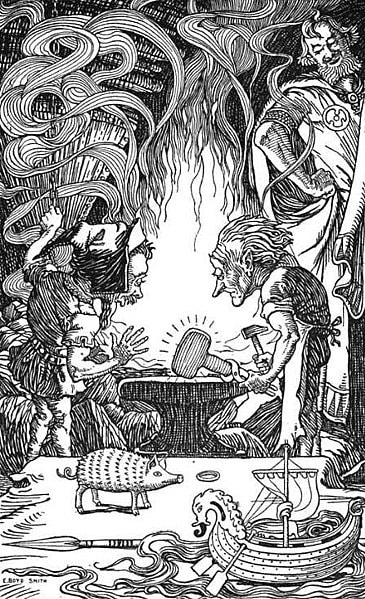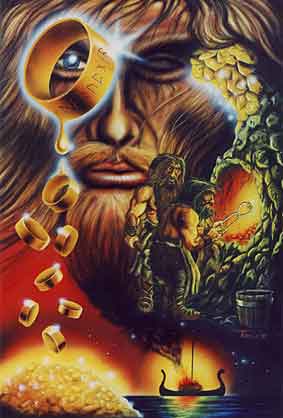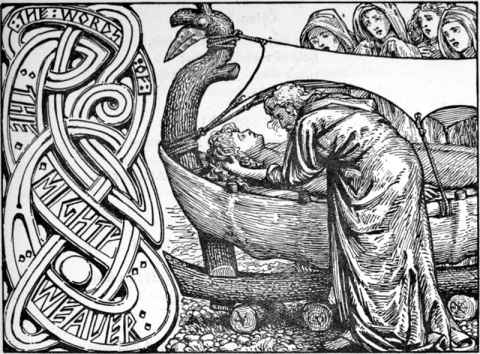Draupnir is a name that resonates deeply within Norse mythology. This isn’t just any ring; it’s an artifact of immense significance, intertwined with tales of gods, dwarves, and legendary events. Owned by Odin, the chief of the Aesir tribe of deities, Draupnir is more than a mere ornament. It embodies power, wealth, and the intricate mysteries that Norse myths are renowned for.
As we delve into the story of Draupnir, we’ll uncover its origins, its magical properties, and its role in various myths. From its creation by skilled dwarves to its association with the Allfather Odin, every facet of Draupnir offers a glimpse into the rich tapestry of Norse legends.
Name and Etymology
The name “Draupnir” carries with it a weight of history and magic. Stemming from the Old Norse word “draup,” it translates to “dripper” or “dropper.” This isn’t a mere coincidence; the name is a direct nod to the ring’s unique ability to produce more of its kind, symbolizing its power to multiply wealth.
In the vast realm of Norse mythology, Draupnir isn’t the only ring with a tale to tell. Take, for instance, Andvaranaut, another magical ring, but one that’s cursed. This ring was owned by the dwarf Andvari, and it brought great wealth to its owner. However, it was stolen by Loki, and its curse played a significant role in the tragic tale of the hero Sigurd and the Valkyrie Brynhild. Then there’s the master smith Völund, who, in his longing for his lost Valkyrie wife, crafted rings in his secluded forge, each piece echoing his hope and sorrow.
Drawing parallels beyond Norse myths, the concept of magical rings is a recurrent theme in various cultures. J.R.R. Tolkien’s One Ring in his Middle-earth saga is a prime example. Tolkien, deeply influenced by Norse mythology, wove elements from these ancient tales into his narrative. The names, the settings, and yes, the magical rings, all hint at his fascination with Norse legends. While Draupnir and the One Ring have distinct narratives and origins, the essence of a powerful ring that holds sway over its surroundings is a shared motif.
Draupnir’s Origin and Creation
The tale of Draupnir’s inception is a riveting mix of mischief, divine craftsmanship, and celestial judgment. Everything began when Loki, in a whimsical act, sheared off all of Sif’s hair. This act infuriated Thor, who threatened dire consequences upon Loki. To rectify his misdeed, Loki promised to procure an even more splendid set of hair for Sif, made of pure gold, and turned to the Dark Elves for assistance.
Loki had always been one to boast, and he had previously extolled the Sons of Ivaldi as the paramount craftsmen among the dwarves. Sindri and Brokkr, however, took umbrage at this claim and challenged it. To validate the craftsmanship of the Sons of Ivaldi, Loki wagered that they could produce artifacts of unparalleled splendor. Accepting the challenge, the Sons of Ivaldi crafted the golden hair for Sif, the ship Skídbladnir, and the spear Gungnir.

Not to be outdone, Sindri and Brokkr began their own crafting process. Despite Loki’s attempts to hinder Sindri by turning into a fly, Sindri, with Brokkr’s assistance, successfully forged three masterpieces: Tyr’s golden boar Gullinbursti, Thor’s hammer Mjölnir, and the gold-generating ring Draupnir.
The moment of reckoning arrived, and the Aesir gods convened for judgment. Loki, with pride, showcased the treasures from the Sons of Ivaldi, while Brokkr presented their own creations. As detailed in the “Skáldskapramál”:
“Then Brokkr brought forward his gifts: he gave to Odin the ring, saying that eight rings of the same weight would drop from it every ninth night.”
This narrative, deeply embedded in Norse lore, paints a vivid picture of Loki’s antics, the unparalleled artistry of the dwarves, and the values held dear by the gods of Asgard.
Description and Abilities
Draupnir, in its splendor, is more than just a piece of jewelry. Picture a ring, radiant with the sheen of pure gold, its surface adorned with intricate Norse runes. While its exact size and design might be left to interpretations, its aura of magic and power is palpable in every tale. Crafted by the meticulous dwarves, known for their unparalleled craftsmanship, Draupnir would undoubtedly be a masterpiece. The very essence of the ring, its ability to produce more gold, suggests a design that’s both elegant and functional. Perhaps it bore magical runes for prosperity or depictions of key moments from Norse myths.

But Draupnir’s true allure lies in its magical abilities. Every ninth night, this ring would produce eight new gold rings, each equal in weight to Draupnir itself. This unique ability made it a symbol of infinite wealth and prosperity in the Norse pantheon. In contrast to the Andvaranaut ring, another famed ring in Norse mythology, Draupnir wasn’t cursed. However, its journey was no less intriguing. The ring would travel to Hel, the land of the dead, and make its way back to the realm of the gods, a tale we’ll explore in depth in the myths section.
Myths Associated with Draupnir
Draupnir, Odin’s magical gold ring, holds a prominent place in Norse mythology, weaving its narrative through various tales that depict its creation, significance, and adventures. From its origin in the skilled hands of dwarves to its poignant journey to the land of the dead and its role in romantic endeavors, Draupnir’s stories offer a glimpse into the rich tapestry of Norse legends.
The Creation of Draupnir: Treasures of the Gods
Draupnir’s origin is deeply rooted in the tales of the dwarves’ unparalleled craftsmanship. As the story goes in the “Treasures of the Gods” from Skáldskapramál, the ring was forged by the dwarf brothers Brokkr and Eitri (or Sindri). This creation was part of a wager with Loki, who claimed that these dwarves couldn’t produce items superior to those made by the Sons of Ivaldi. Draupnir was one of the three majestic gifts, alongside Mjöllnir and Gullinbursti. In the end, Thor’s hammer, Mjöllnir, clinched the victory for Brokkr and Eitri, showcasing the unmatched artistry of these dwarves.
The Death of Baldur and Draupnir’s Journey to Hel

In the tragic tale of Baldur’s death, as detailed in the Prose Edda’s “Gylfaginning” Odin, in his profound grief, placed Draupnir on Baldur’s funeral pyre. The ring’s presence was symbolic, representing the wealth and prosperity Baldur brought to the gods. The text mentions:
“Odin laid upon the pyre the gold ring called Draupnir; this quality attended it: that every ninth night there fell from it eight gold rings of equal weight.”
However, the ring’s journey didn’t end there. When Hermod visited the land of the dead to see Baldur and his wife Nanna, Baldur sent Draupnir back with him as a token for Odin, signifying the eternal bond between father and son.
Draupnir in Skírnismál: The Wooing of Gerðr
Draupnir’s tales continue in the poem “Skírnismál,” where it plays a pivotal role in the wooing of the giantess Gerðr. Freyr, smitten by Gerðr’s beauty, sends his servant Skírnir to win her heart on his behalf. As a token of his sincerity and to persuade Gerðr, Skírnir offers Draupnir. The poem beautifully captures this moment in stanza 21 and 22:
Skirnir Spoke:
“Then I bring you | the ring that was burned
In the past with Odin’s son;
From it, eight rings | of equal weight fall
On every ninth night.”
Gerd Spoke:
“I don’t want the ring, | even though it was burned
In the past with Odin’s son;
In Gymir’s home | there is no shortage of gold
With the wealth my father holds.”
Through these myths, Draupnir’s significance in Norse mythology is evident. It’s not just a ring; it’s a symbol of wealth, a token of love, and a bridge between the worlds of the living and the dead.
Frequently Asked Questions
Draupnir is derived from the Old Norse word “draup,” meaning “dripper” or “dropper,” referencing its unique ability to produce gold rings.
The magical ring Draupnir was crafted by the skilled dwarf brothers, Brokk and Sindri (or Eitri).
Every ninth night, Draupnir drips eight new gold rings, each equal in weight to itself.
While many mythologies feature magical rings, Draupnir stands out with its ability to multiply wealth and its deep-rooted significance in Norse myths.
While no real artifact possesses Draupnir’s magical abilities, its legend has inspired various artworks, jewelry designs, and literary works over the centuries.
Featured Image Credit: Elmer Boyd Smith (1860 – 1943), Public domain, via Wikimedia Commons

Hello there,
I found this very insightful, especially the symbolism that drupnir has with the ring. I myself am a seidr madr practitioner, who looks at everything through a shamanic animist lense.
What else is a ring? Jormungandr, the sun, wheel of the year, chakras. The way it follows Baldur to the underworld and back up, when the rings also represent the soul and its 8 parts, as well as the wheel of the year, Especially when you consider Baldur’s death & Rebirth symbolism, ego & dark night of the soul, summer to winter & over, With freyr & Gerd as well, representing the stubbornness of the changing seasons, winter to summer. So He didn’t just try to – bribe her with Apples, Freyr’s sword, and then finally threaten to kill her –
Myth’s aren’t to be taken that literally.
He offered immortality, male virility, and life itself, then finally, because Freyjr is sunshine, the threat that spring would not come if she didn’t marry him, which I think in the past this would have come across as more alluding to fate, than issuing a threat.
Anyways,thank you.
Good day, Blessed be.
Hey Hakin, thanks for the comment! Much appreciated feedback and interesting point of view on Draupnir, and rings in general!
Marius